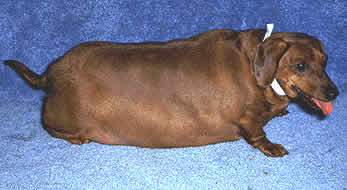 Dr. Tracy Acosta
Dr. Tracy Acosta November 30 , 2006---
As we enter into the holiday season with full Thanksgiving bellies, I put out a call to all pet owners to truly consider the effects of healthy food choices for their pets.
Previously, I have discussed the importance of maintaining a healthy body weight for each of your pets, so that they may live to their full life expectancy. Repeatedly, veterinarians preach the dangers of obesity, as it is the No. 1 nutritional disorder seen by small animal practitioners.
All pet owners should take this advice seriously, since obesity can lead to life threatening medical conditions, including diabetes mellitus.
Obviously, I love the fact that our pets have become such an integral part of our lives with a majority of pet owners considering their four-legged companions truly as a member of the family. However, this does not and must not mean that our pets follow our bad human trends when it comes to what we eat.
Especially, now more than ever, with the excellent array of commercial pet foods that provide our pets with proper nutrition, no owner needs to "supplement" their pet's diet. Through my interactions with pet owners I hear repeatedly how pets receive table scraps or "special treats." The excuses are many but usually involve some sort of sentiment referring to the way many owners just cannot refuse such a sweet face with those big, sad eyes.
Well, have you ever heard of tough love? There are too many ways to reward or to love your pet without inappropriate feeding. In fact, many pet owners are killing their pets, slowly but surely, by giving in and feeding inappropriate foods, thus creating pets that are extremely obese. I hate to be so blunt, but it is so frustrating to see this problem escalating to unbelievable numbers.
From my perspective, not only are the human waistlines of America expanding, but so are the waistlines of their pets. With the increase in obesity in pets, so does the incidence of diabetes.
Obviously, obesity is not the only cause of diabetes in pets, but it increases the likelihood. Diabetes can be treated and controlled in our pets, but because of the multitude of health complications secondary to diabetes, prevention and avoidance of this powerful hormonal disease is best.
As a quick overview of diabetes mellitus in pets, there are two types. Type I is a result of an overall deficiency in which the pet's body does not produce enough insulin. With Type II diabetes, the pancreas produces enough insulin, but something prevents the pet's body from using it properly. Type I is the most common form seen in pets.
Some of the common clinical signs owners can notice are: lethargy; increase in thirst; increase in urination; sudden weight loss; and sudden cataract formation. If you ever notice any of these signs, have your pet seen and evaluated immediately, since these same symptoms can be associated with diabetes as well as other serious medical conditions.
Diagnosis of diabetes includes blood work, urinalysis, physical exam and sometimes abdominal X-rays or ultrasound. Many pets when first diagnosed have extremely elevated blood glucose (sugar) levels and significant urinary tract infections.
If your pet is diagnosed with diabetes, it is not a death sentence. There are many ways to treat and control this disease, but it takes commitment by the owner to provide consistent care for the rest of that pet's life.
Treatment in pets is similar to that in humans: insulin injections, modified diet and frequent monitoring. Most pets receive one to two injections of insulin daily to help maintain a consistent blood glucose. Initially, most pets are hospitalized during the first two to four days of insulin therapy to adjust and monitor a pet's response to the insulin.
It is important to note that it is easy to show owners how to properly administer insulin injections to their pets so that everyone is comfortable with the process. Most owners fret and panic when they are first told that their pet will now require insulin injections daily.
However, once it is demonstrated how easy it really is and that a very small needle is used, owners can feel confident about their pets' care at home. In fact, most owners are shocked at how little their pet responds to the insulin injection with the tiny, specially designed insulin syringes and needles.
Once a protocol is established, the owner is able to provide a consistent routine and schedule for feeding and insulin injections. Some can even monitor their pets' blood glucose at home, if their pets are cooperative. Otherwise, regularly scheduled follow-ups with the veterinarian are recommended.
I again beg from my soapbox that all pet owners realize the significance of and proper nutrition for their pets. Obesity is an epidemic but preventable. Not only will your pets live longer, but you will also avoid the heartache of secondary and serious life shortening medical conditions.
|